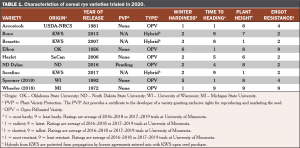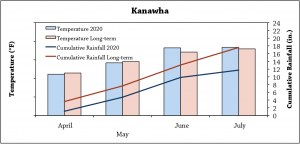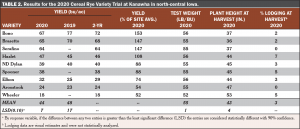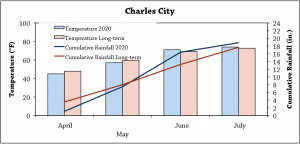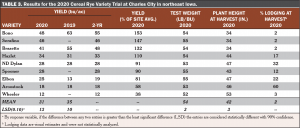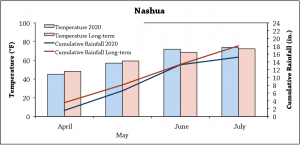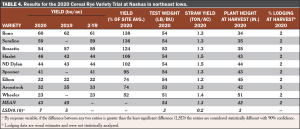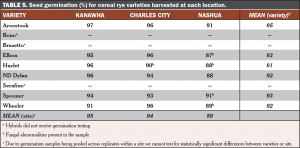This project was funded by Walton Family Foundation and Albert Lea Seed House
In a Nutshell:
-
Nine cereal rye varieties were screened at two Iowa State University research farms and one commercial farm.
Key Findings:
- Across sites and varieties, average cereal rye yield was 39 bu/ac.
- Hybrid varieties, Bono, Brasetto and Serafino, were the top-yielding varieties at each site.
- Hazlet and ND Dylan, more-recently-released open-pollinated varieties, were intermediate yield performers across sites.
Background
Cereal rye has recently gained attention as a winter cover crop in corn-soybean production systems. Seeded in the fall, cereal rye will grow before going into winter dormancy and resume growth early the following spring. When managed as a cash crop, cereal rye is harvested for grain in mid- to late July and field management options for the remainder of the season are numerous. These include establishment of a perennial forage or summer cover crop, as well as an opportunity for mid-season manure application. As farmers begin to plant cereal rye for various purposes – cover crop seed, grain, straw, forage, hay or haylage production – they might seek to plant cereal rye varieties with distinct production characteristics.
This was the second year that Practical Farmers of Iowa coordinated cereal rye variety trials on university and commercial farms. In 2019, the average cereal rye yield across three sites in northern Iowa was 43 bu/ac.[1]Recent cereal rye variety trials conducted by the University of Minnesota, however, reported an average yield of 77 bu/ac in 2018[2] and 68 bu/ac in 2019.[3]
Methods
Variety trials were conducted at three locations in 2020: ISU Northern Research Farm in Kanawha; ISU Northeast Research Farm in Nashua; Wendy Johnson’s farm in Charles City. Production characteristics and some breeding history about each of the trialed varieties can be found in Table 1. Information on winter hardiness, days to heading, plant height and ergot susceptibility was sourced from the University of Minnesota.[2,3]
Rye management information is provided with the results from each location. No herbicide, insecticide or fungicide were applied at any location. Data were analyzed using JMP Pro 15 (SAS Institute Inc., Cary, NC). Statistical significance is determined at P ≤ 0.10 level and means separations are reported using Tukey’s least significant difference (LSD).
Rye seed samples from each location were sent to the Iowa State Seed Testing Laboratory for germination testing. Samples were pooled across replicates at each site and this precluded us from analyzing these germination data statistically. As such, please keep in mind: We present germination percentages in this report as a rough comparison among varieties and locations.
Results and Discussion
Data were analyzed by location and varieties are listed in order of 2020 yield performance. Reported yields are corrected for 14% moisture. A “percentage of test average” calculation for 2020 is included to aid in comparing among entries at each location. The two-year yield average is provided for varieties that were also trialed in 2019. Rainfall and temperature data were accessed from the nearest weather station.[4] All three sites saw rainfall amounts less than the historical averages for April and May – particularly the ISU Northern Research Farm at Kanawha which also experienced low rainfall through June and July.
Bono, Brasetto and Serafino, all hybrid varieties developed by KWS, were the top yield performers at each location. The hybrids were also significantly shorter in stature than the open-pollinated varieties (sometimes by as much as 10 in.). The newer open-pollinated varieties, Hazlet and ND Dylan, were intermediate in terms of yield at each location. Most varieties had germination rates above 90% across sites (Table 5).
ISU Northern Research Farm, Kanawha
Previous crop: Soybeans
Replications: 3
Plot size: 5 ft × 57 ft
Fertilizer applied: 720 lb K/ac as potash on Nov. 22, 2019
102 lb N/ac and 480 lb P/ac as MAP on Nov. 25, 2019
Note: P and K were applied based on an estimated 4-year crop removal rate.
Planting date: Oct. 19, 2019 with no-till drill
Row spacing: 7.5 in.
Seeding rate: 23 seeds/ft2
Rate on weight basis to achieve target population: Aroostook (56 lb/ac), Bono (85 lb/ac), Brasetto (54 lb/ac), Elbon (76 lb/ac), Hazlet (76 lb/ac), ND Dylan (69 lb/ac), Serafino (107 lb/ac), Spooner (90 lb/ac), Wheeler (84 lb/ac)
Seeding depth: 1.25 in.
Harvest date: July 22, 2020

Harvesting cereal rye variety trial plots at Wendy Johnson’s farm near Charles City on July 23, 2020.
Wendy Johnson’s Farm, Charles City
Previous crop: Soybeans
Replications: 3
Plot size: 5 ft × 58 ft
Fertilizer applied: 30 lb N/ac, 34 lb P/ac, 71 lb K/ac on Oct. 14, 2019
Planting date: Oct. 18, 2019 with no-till drill
Row spacing: 7.5 in.
Seeding rate: 23 seeds/ft2
Rate on weight basis to achieve target population: Aroostook (56 lb/ac), Bono (85 lb/ac), Brasetto (54 lb/ac), Elbon (76 lb/ac), Hazlet (76 lb/ac), ND Dylan (70 lb/ac), Serafino (107 lb/ac), Spooner (90 lb/ac), Wheeler (84 lb/ac)
Seeding depth: 1.25 in.
Harvest date: July 23, 2020
ISU Northeast Research Farm, Nashua
Previous crop: Soybeans
Replications: 3
Plot size: 8 ft × 50 ft
Fertilizer applied: 60 lb P/ac and 267 lb K/ac on Nov. 13, 2019
Planting date: Oct. 17, 2019 with no-till drill followed by culipacker
Row spacing: 7.5 in.
Seeding rate: 23 seeds/ft2
Rate on weight basis to achieve target population: Aroostook (56 lb/ac), Bono (85 lb/ac), Brasetto (54 lb/ac), Elbon (76 lb/ac), Hazlet (76 lb/ac), ND Dylan (70 lb/ac), Serafino (107 lb/ac), Spooner (90 lb/ac), Wheeler (84 lb/ac)
Seeding depth: 1.25 in.
Harvest date: July 20, 2020
Conclusions and Next Steps
Desired cereal rye characteristics vary depending on intended purpose of the crop. For instance, if harvesting grain for livestock feed was the main priority in planting cereal rye, high-yielding hybrid varieties such as Bono, Brasetto or Serafino might be optimal choices. If the intended purpose is haylage, the varieties Wheeler or Aroostook, with their tall plant height, might be preferable to the shorter hybrids. In contrast, if someone were growing cereal rye as a seed crop (e.g., for cover crop seed) to be used on their own farm, they would avoid hybrid varieties and seek high yield with little lodging coupled with high seed germination. Farmers intending to sell cereal rye seed for cover crops to be sold off their farm need to be familiar with intellectual property considerations and the licensing process for those varieties with plant variety protection.
With the compiled information on plant protection status, winter hardiness, days to heading, plant height, and ergot susceptibility, alongside the researched characteristics of yield, test weight, plant height, and percent lodging, a farmer in Iowa can determine which cereal rye variety will best meet their production goals.
References
-
Gailans, S. 2019. Cereal Rye Variety Trial 2019. Practical Farmers of Iowa Cooperators’ Program. https://practicalfarmers.org/research/cereal-rye-variety-trial-2019/ (accessed August 2020).
- Wiersma, J., S. Wells, A. Garcia y Garcia, D. Grafstrom, H. Lindell and S. Quiring. 2018. 2018 Winter Rye Field Crop Trials Results. University of Minnesota. https://www.maes.umn.edu/sites/maes.umn.edu/files/2018_winter_rye_final.pdf (accessed August 2020).
-
Wiersma, J., S. Wells and A. Garcia y Garcia. 2019. 2019 Rye Field Crop Trials Results. University of Minnesota. https://www.maes.umn.edu/sites/maes.umn. edu/files/2019_rye_final.pdf (accessed August 2020).
-
Iowa Environmental Mesonet. 2020. Climodat Reports. Iowa State University. http://mesonet.agron.iastate.edu/climodat/ (accessed August 2020).


